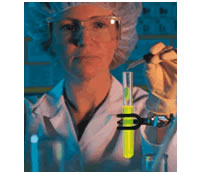- Home
- Public Employees Occupational Safety and Health
- PEOSH Health Standards
- PEOSH Occupational Exposure to Hazardous Chemicals in Laboratories Standard (29 CFR 1910.1450)
PEOSH Occupational Exposure to Hazardous Chemicals in Laboratories Standard (29 CFR 1910.1450)
The PEOSH Occupational Exposure to Hazardous Chemicals in Laboratories Standard, referred to on this page as the “PEOSH Laboratory Standard,” establishes minimum requirements for chemical hygiene practices in laboratories in New Jersey. The Standard includes requirements for a written chemical hygiene program, labeling, use, and handling of hazardous chemicals in a laboratory setting.
The PEOSH Occupational Exposure to Hazardous Chemicals in Laboratories standard has been adopted from the U.S. Department of Labor 29 CFR 1910.1450.
- Model Written Chemical Hygiene Plan
[doc 75k] [pdf 31k]
This model written program provides a template for employers who are preparing a Written Chemical Hygiene Plan and includes all required components. Minor modification is required to customize the plan to reflect site-specific hazards and employer policies and procedures. - NIOSH School Chemistry Laboratory Safety Guide
The guide presents information about ordering, using, storing, and maintaining chemicals in the high school laboratory. The guide also provides information about chemical waste, safety and emergency equipment, assessing chemical hazards, common safety symbols and signs, and fundamental resources relating to chemical safety, such as Material Safety Data Sheets and Chemical Hygiene Plans, to help create a safe environment for learning. In addition, checklists are provided for both teachers and students that highlight important information for working in the laboratory and identify hazards and safe work procedures.
This guide is not intended to address all safety issues, but rather to provide basic information about important components of safety in the chemistry laboratory and to serve as a resource to locate further information.
Q: Does the PEOSH Laboratory Standard apply to all public school science laboratories?
A: The Standard applies to laboratories that are engaged in the laboratory use of hazardous chemicals on a laboratory scale. Laboratory use of hazardous chemicals means handling or use of such chemicals in which all of the following conditions are met:
- Chemical manipulations are carried out on a laboratory scale;
- Multiple chemical procedures or chemicals are used;
- The procedures involved are not part of a production process, nor in any way simulate a production process; and
- Protective laboratory practices and equipment" are available and in common use to minimize the potential for employee exposure to hazardous chemicals.
 Laboratory scale is defined as "work with substances in which the containers used for reactions, transfers, and other handling of substances are designed to be easily and safely manipulated by one person." There are specific exemptions in the Standard for dip and read kits and commercially prepared kits where hazardous substances are contained within a sealed media and employee's potential exposure is minimal. Application of the Standard to public school science laboratories is based on the specific work practices at your laboratory. The Standard is more likely to apply to advanced high-school level chemistry laboratories using wet methods, but unlikely to apply to general science demonstrations. Schools are also less likely to limit the use of hazardous reagents for student safety purposes.
Laboratory scale is defined as "work with substances in which the containers used for reactions, transfers, and other handling of substances are designed to be easily and safely manipulated by one person." There are specific exemptions in the Standard for dip and read kits and commercially prepared kits where hazardous substances are contained within a sealed media and employee's potential exposure is minimal. Application of the Standard to public school science laboratories is based on the specific work practices at your laboratory. The Standard is more likely to apply to advanced high-school level chemistry laboratories using wet methods, but unlikely to apply to general science demonstrations. Schools are also less likely to limit the use of hazardous reagents for student safety purposes.
Q: Do I have to comply with the PEOSH Hazard Communication Standard if I am in compliance with the PEOSH Laboratory Standard?
A: The PEOSH Laboratory Standard is considered to be more specific to the laboratory setting than the PEOSH Hazard Communication Standard. If the employer is in compliance with the PEOSH Laboratory Standard, those covered employees are exempt from the requirements of the PEOSH Hazard Communication Standard.


